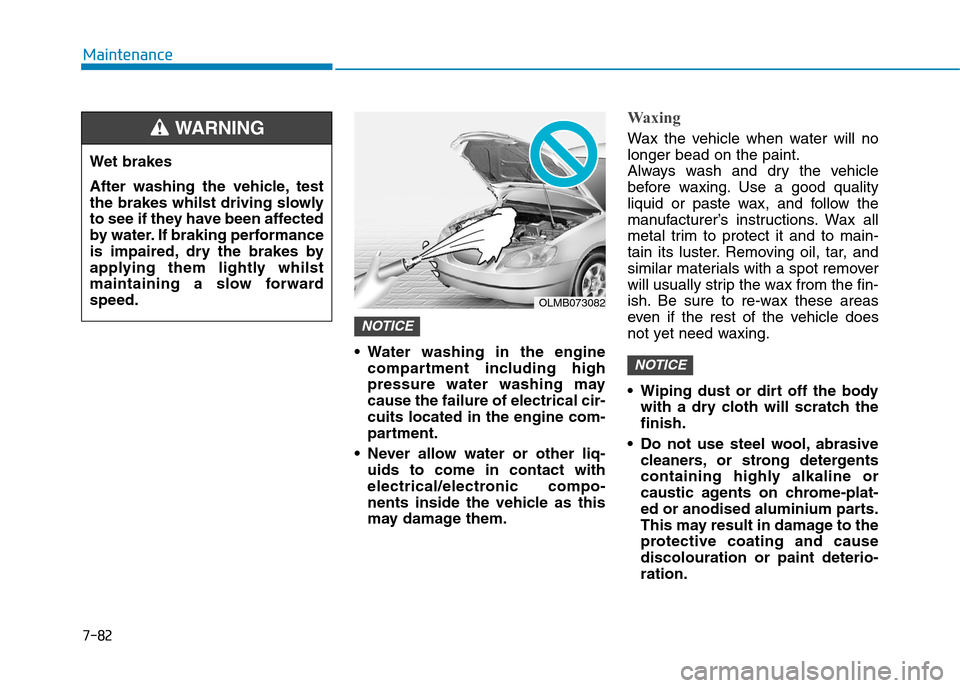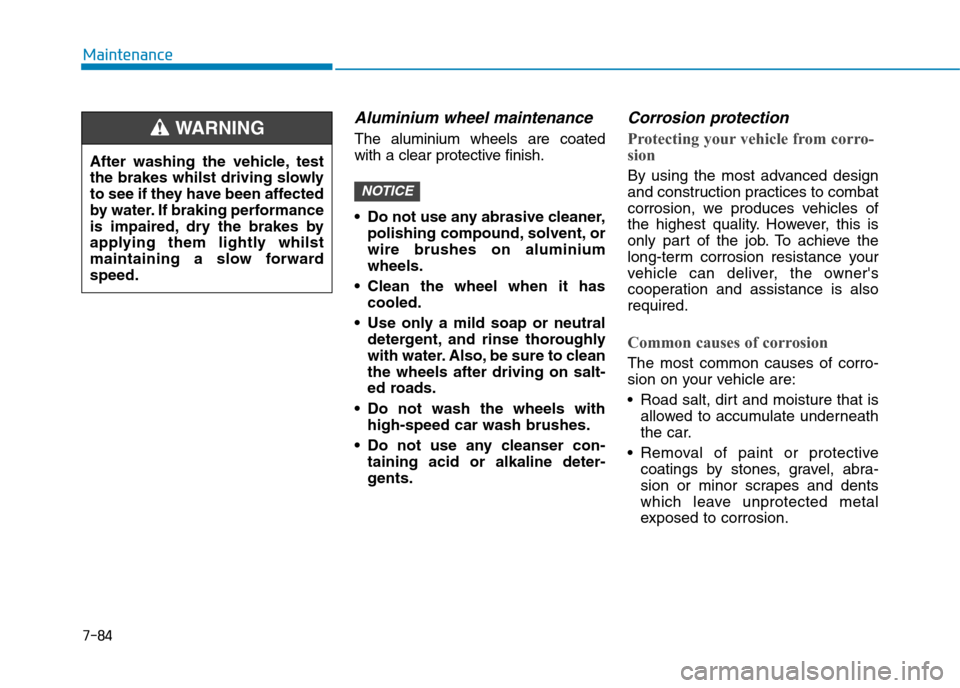Page 547 of 571
7-77
7
Maintenance
6.Remove the bulb from the socket
by pressing it in and rotating it anti-
clockwise until the tabs on the bulb
align with the slots in the socket.
Pull the bulb out of the socket.
7.Insert a new bulb by inserting it into
the socket and rotating it until it
locks into place.
8.Install the socket in the assembly
by aligning the tabs on the socket
with the slots in the assembly.
Push the socket into the assembly
and turn the socket clockwise.
Inside lamp
1.Open the boot.
2.Loosen the retaining screw of the
boot lid cover and then remove the
cover.
3.Disconnect the connector and then
remove the nuts by turning the nuts
anticlockwise.
Reverse lamp
1.Take the light assembly out.
OAD075056
OAD075055
OAD075052
Page 548 of 571

7-78
Maintenance
2.Remove the socket from the
assembly by turning the socket
anticlockwise until the tabs on the
socket align with the slots on the
assembly.
3.Remove the bulb by pulling it out.
4.Insert a new bulb by inserting it into
the socket.
5.Install the light assembly to the
boot.
6.Reinstall the nuts and connector
and then the boot lid cover by
pushing in the screw.
Tail and rear fog lamp (if equipped)
1.Remove the socket from the
assembly by turning the socket
anticlockwise until the tabs on the
socket align with the slots on the
assembly.
2.Remove the bulb from the socket
by pressing it in and rotating it anti-
clockwise until the tabs on the bulb
align with the slots in the socket.
Pull the bulb out of the socket.
3.Insert a new bulb by inserting it into
the socket and rotating it until it
locks into place.
4.Install the socket in the assembly
by aligning the tabs on the socket
with the slots in the assembly.
Push the socket into the assembly
and turn the socket clockwise.
OAD075069L
OAD075070L
■Ty p e A
■Ty p e B , C
Back up
Ta i lFog(if equipped)
Fog(if equipped)
Back up
Page 549 of 571
7-79
7
Maintenance
High mounted stop lamp
replacement
1.Open the boot.
2.Remove the socket by turning it
anticlockwise until the tabs on the
socket align with the slots.
3.Remove the bulb from the socket
by pressing it in and rotating it anti-
clockwise until the tabs on the bulb
align with the slots in the socket.
Pull the bulb out of the socket.
4.Insert a new bulb by inserting it into
the socket and rotating it until it
locks into place.
5.Install the socket in the assembly
by aligning the tabs on the socket
with the slots in the assembly.
Push the socket into the assembly
and turn the socket clockwise.
Licence plate light bulb
replacement
1.Remove the cover by pressing it in
the direction of the arrows.
2.Remove the bulb by pulling it
straight out.
3.Install a new bulb.
4.Reinstall in the reverse order.
OAD075043
OAD075041
OAD075042
Page 550 of 571
7-80
Maintenance
Interior light bulb replacement1.Using a flat-blade screwdriver,
gently pry the lens from the interior
light housing.
2.Remove the bulb by pulling it
straight out.
3.Install a new bulb in the socket.
4.Align the lens tabs with the interior
light housing notches and snap the
lens into place.
Prior to working on the Interior
Lights, ensure that the “OFF”
button is pressed to avoid burn-
ing your fingers or receiving an
electric shock.
WA R N I N G
Use care not to dirty or damage
lens, lens tab, and plastic hous-
ings.
CAUTION
■Map lamp
OAD075044
OAD075045
■Luggage compartment lamp
■Sunvisor lamp
OAD075047
OAD075046
■Passenger compar tment lamp
Page 551 of 571

7-81
7
Maintenance
AAPPPPEEAARRAANNCCEE CCAARREE
Exterior care
Exterior general caution
It is very important to follow the label
directions when using any chemical
cleaner or polish. Read all warning
and caution statements that appear
on the label.
High-pressure washing
•When using high-pressure wash-
ers, make sure to maintain suffi-
cient distance from the vehicle.
Insufficient clearance or excessive
pressure can lead to component
damage or water penetration.
•Do not spray the camera, sensors
or its surrounding area directly with
a high pressure washer. Shock
applied from high pressure water
may cause the device to not oper-
ate normally.
•Do not bring the nozzle tip close to
boots (rubber or plastic covers) or
connectors as they may be dam-
aged if they come into contact with
high pressure water.
Finish maintenance
Washing
To h e l p p r o t e c t y o u r v e h i c l e ’ s f i n i s h
from rust and deterioration, wash it
thoroughly and frequently at least
once a month with lukewarm or cold
water.
If you use your vehicle for off-road
driving, you should wash it after each
off-road trip. Pay special attention to
the removal of any accumulation of
salt, dirt, mud, and other foreign
materials. Make sure the drain holes
in the lower edges of the doors and
rocker panels are kept clear and
clean.
Insects, tar, tree sap, bird droppings,
industrial pollution and similar
deposits can damage your vehicle’s
finish if not removed immediately.
Even prompt washing with plain
water may not completely remove all
these deposits.
A mild soap, safe for use on painted
surfaces, may be used.
After washing, rinse the vehicle thor-
oughly with lukewarm or cold water.
Do not allow soap to dry on the finish.
•Do not use strong soap,chemi-
cal detergents or hot water, and
do not wash the vehicle in direct
sunlight or when the body of the
vehicle is warm.
•Be careful when washing the
side windows of your vehicle.
Especially, with high-pressure
water, water may leak through
the windows and wet the interi-
or.
•To prevent damage to the plastic
parts and lamps, do not clean
with chemical solvents or strong
detergents.
NOTICE
Page 552 of 571

7-82
Maintenance
•Water washing in the engine
compartment including high
pressure water washing may
cause the failure of electrical cir-
cuits located in the engine com-
partment.
•Never allow water or other liq-
uids to come in contact with
electrical/electronic compo-
nents inside the vehicle as this
may damage them.
Waxing
Wax the vehicle when water will no
longer bead on the paint.
Always wash and dry the vehicle
before waxing. Use a good quality
liquid or paste wax, and follow the
manufacturer’s instructions. Wax all
metal trim to protect it and to main-
tain its luster. Removing oil, tar, and
similar materials with a spot remover
will usually strip the wax from the fin-
ish. Be sure to re-wax these areas
even if the rest of the vehicle does
not yet need waxing.
•Wiping dust or dirt off the body
with a dry cloth will scratch the
finish.
•Do not use steel wool,abrasive
cleaners, or strong detergents
containing highly alkaline or
caustic agents on chrome-plat-
ed or anodised aluminium parts.
This may result in damage to the
protective coating and cause
discolouration or paint deterio-
ration.
NOTICE
NOTICE
Wet brakes
After washing the vehicle, test
the brakes whilst driving slowly
to see if they have been affected
by water. If braking performance
is impaired, dry the brakes by
applying them lightly whilst
maintaining a slow forward
speed.
WA R N I N G
OLMB073082
Page 553 of 571

7-83
7
Maintenance
Finish damage repair
Deep scratches or stone chips in the
painted surface must be repaired
promptly. Exposed metal will quickly
rust and may develop into a major
repair expense.
If your vehicle is damaged and
requires any metal repair or
replacement, be sure the body
shop applies anti-corrosion materi-
als to the parts repaired or replaced.
Bright-metal maintenance
•To remove road tar and insects,
use a tar remover, not a scraper or
other sharp object.
•To protect the surfaces of bright-
metal parts from corrosion, apply a
coating of wax or chrome preser-
vative and rub to a high luster.
•During winter weather or in coastal
areas, cover the bright metal parts
with a heavier coating of wax or
preservative. If necessary, coat the
parts with non-corrosive petroleum
jelly or other protective compound.
Underbody maintenance
Corrosive materials used for ice and
snow removal and dust control may
collect on the underbody. If these
materials are not removed, acceler-
ated rusting can occur on underbody
parts such as the fuel lines, frame,
floor pan and exhaust system, even
though they have been treated with
rust protection.
Thoroughly flush the vehicle under-
body and wheel openings with luke-
warm or cold water once a month,
after off-road driving and at the end of
each winter. Pay special attention to
these areas because it is difficult to
see all the mud and dirt. It will do
more harm than good to wet down the
road grime without removing it. The
lower edges of doors, rocker panels,
and frame members have drain holes
that should not be allowed to clog with
dirt; trapped water in these areas can
cause rusting.
NOTICE
Page 554 of 571

7-84
Maintenance
Aluminium wheel maintenance
The aluminium wheels are coated
with a clear protective finish.
•Do not use any abrasive cleaner,
polishing compound, solvent, or
wire brushes on aluminium
wheels.
•Clean the wheel when it has
cooled.
•Use only a mild soap or neutral
detergent, and rinse thoroughly
with water. Also, be sure to clean
the wheels after driving on salt-
ed roads.
•Do not wash the wheels with
high-speed car wash brushes.
•Do not use any cleanser con-
taining acid or alkaline deter-
gents.
Corrosion protection
Protecting your vehicle from corro-
sion
By using the most advanced design
and construction practices to combat
corrosion, we produces vehicles of
the highest quality. However, this is
only part of the job. To achieve the
long-term corrosion resistance your
vehicle can deliver, the owner's
cooperation and assistance is also
required.
Common causes of corrosion
The most common causes of corro-
sion on your vehicle are:
• Road salt, dirt and moisture that is
allowed to accumulate underneath
the car.
• Removal of paint or protective
coatings by stones, gravel, abra-
sion or minor scrapes and dents
which leave unprotected metal
exposed to corrosion.
NOTICE
After washing the vehicle, test
the brakes whilst driving slowly
to see if they have been affected
by water. If braking performance
is impaired, dry the brakes by
applying them lightly whilst
maintaining a slow forward
speed.
WA R N I N G